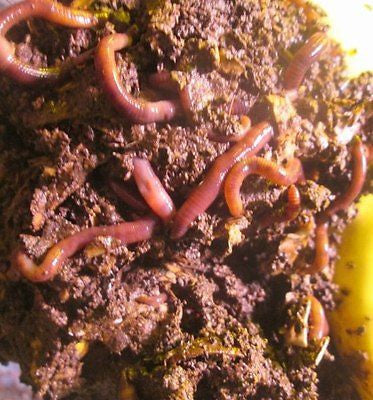Easy-to-care-for red worms: Boost soil nutrients
Easy-to-care-for red worms: Boost soil nutrients
Blog Article
Rise Dirt Wellness Naturally With Red Wigglers
The integration of red wigglers right into dirt management methods offers a compelling technique for enhancing soil wellness naturally. These earthworms not only change natural waste into beneficial vermicompost, however their all-natural behaviors likewise advertise enhanced dirt structure, oygenation, and nutrition availability. However, recognizing the details of establishing and preserving an effective vermicomposting system is vital to completely take advantage of their advantages. Discovering the essential actions and potential obstacles included can substantially impact the performance of this sustainable strategy. What vital elements should be taken into consideration to take full advantage of the benefits of these amazing decomposers?
Benefits of Red Wigglers

Moreover, red wigglers boost soil framework by creating networks as they tunnel with the earth. This activity improves aeration and drain, promoting origin development and guaranteeing that plants obtain appropriate oxygen and dampness. In addition, the castings generated by red wigglers are high in nutrients such as nitrogen, phosphorus, and potassium, which are important for plant growth.
Red wigglers additionally help in the decrease of dangerous pathogens and pests by outcompeting them for resources, additionally adding to a healthier dirt atmosphere. Their presence can lead to a reduction in the requirement for synthetic fertilizers and pesticides, advertising sustainable agricultural practices. In general, incorporating red wigglers right into soil management techniques offers an all-natural and efficient ways of boosting soil vigor, thus sustaining robust plant development and agricultural efficiency.
Establishing Up Vermicomposting
Developing a vermicomposting system is a sensible means to harness the amazing advantages of red wigglers in improving dirt wellness. red wigglers. To start, pick an ideal container-- ideally, a plastic or wood bin with a lid to preserve moisture and temperature level. The container needs to have water drainage openings to avoid excess water buildup
Following, prepare bed linen product, which acts as a habitat for the worms. Appropriate materials consist of shredded paper, cardboard, or coconut coir. Goal for a deepness of 4-6 inches to offer ample room for the worms.
Once the bed linen remains in area, present the red wigglers, generally at a ratio of one pound of worms for every single square foot of surface area in the bin. Following this, add cooking area scraps such as vegetables and fruit peels, coffee premises, and smashed eggshells. Stay clear of meat, milk, and oily foods, as these can bring in parasites.
(red worms for composting)
Caring for Your Worms
Preserving the well-being of your red wigglers is vital for a thriving vermicomposting system. Appropriate care makes sure that these advantageous organisms can efficiently damage down organic issue and improve your soil.
Feeding your worms is one more vital element of their treatment. Red wigglers prosper on kitchen area scraps such as fruit and vegetable peels, coffee grounds, and smashed eggshells. Prevent feeding them citrus fruits, onions, and dairy items, as these can create an unwelcoming atmosphere. Display the quantity of food you offer to avoid overfeeding, which can result in odor problems and draw in parasites.
Temperature level management is essential; worms prefer an array of 55 to 77 levels Fahrenheit. By adhering to these guidelines, you will certainly foster a healthy and balanced ecosystem for your red wigglers.
Utilizing Worm Castings in Soil
Worm spreadings, often described as "black gold," are an effective change that can dramatically boost dirt health and wellness and fertility. red wigglers. These nutrient-rich, natural plant foods are created by red wigglers throughout their food digestion process, resulting in a finely distinctive material that is valuable for plants and soil alike
Including worm castings right into your soil enhances its structure, improving oygenation and water retention. This is particularly useful for sandy dirts that drain pipes too quickly, in addition to heavy clay dirts that can become compressed. Worm spreadings are packed with vital nutrients, including nitrogen, phosphorus, and potassium, which are essential for plant growth.

Inevitably, making use of worm spreadings fosters a growing environment within the soil, resulting in much healthier plants and more lasting gardening techniques.
Tips for Effective Composting
Effective composting needs mindful focus to a few vital concepts that can significantly enhance the top quality of the end product. Equilibrium is essential; keep an appropriate ratio of green materials (nitrogen-rich) to brown materials (carbon-rich), preferably around 1:3. This balance promotes efficient disintegration and lessens smells.
2nd, oygenation plays a crucial duty. Frequently turning the compost heap enhances oxygen flow, which accelerates microbial task and rates up the composting process. Purpose for a heap dimension of a minimum of 3 feet by 3 feet to keep warm, which even more promotes decay.
(Lake Rhodhiss Bait)
Moisture web content is one more important element; the garden compost should be moist however not soaked. A good general rule is to attain a wetness level similar to that of a wrung-out sponge. Also much water can result in anaerobic problems, while insufficient can decrease decay.
Lastly, keep an eye on the temperature of the garden compost. A temperature range of 130 ° F Clicking Here to 160 ° F indicates active composting and aids eliminate microorganisms and weed seeds. By adhering to these concepts, you will develop a nutrient-rich compost that sustains dirt health and boosts plant growth.
Verdict
Integrating red wigglers into gardening techniques improves dirt wellness via natural processes. These worms contribute to the breakdown of natural products, resulting in nutrient-rich vermicompost that boosts soil structure and fertility.
Report this page